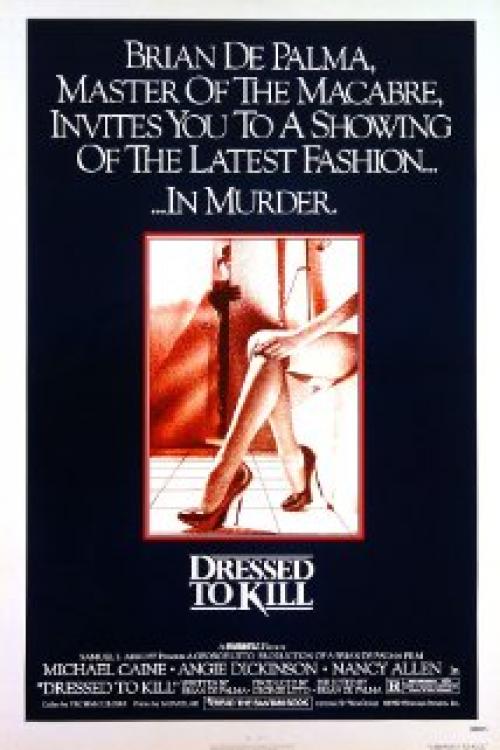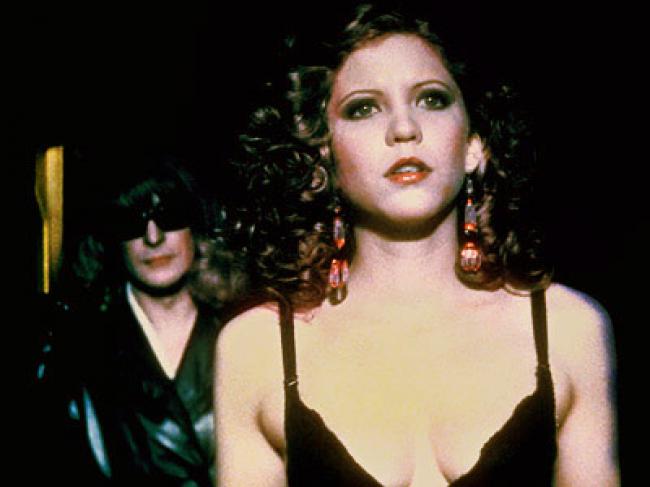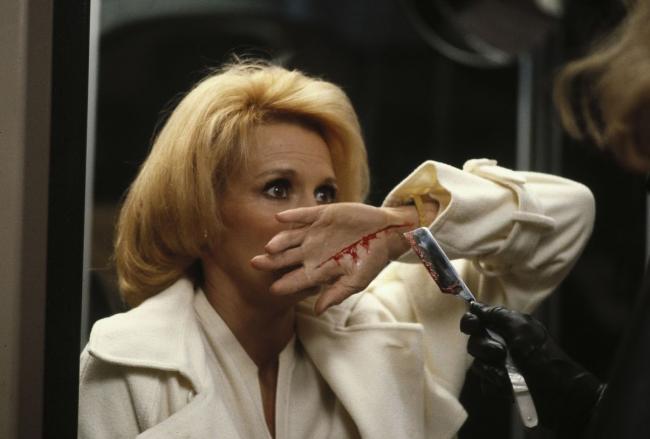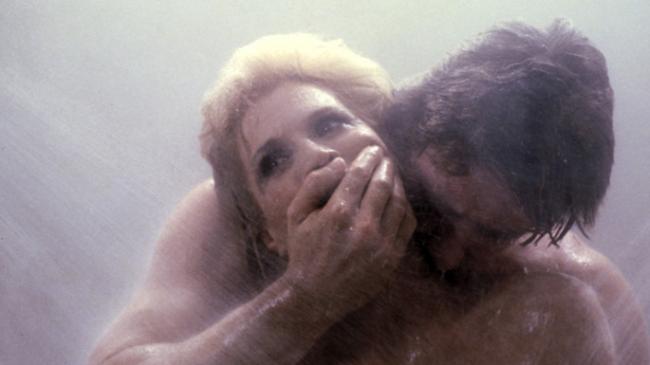Movie Review
Dressed to Kill
The latest fashion in murder.
US Release Date: 07-25-1980
Directed by: Brian De Palma
Starring▸▾
- Michael Caine, as
- Doctor Robert Elliott
- Angie Dickinson, as
- Kate Miller
- Nancy Allen, as
- Liz Blake
- Keith Gordon, as
- Peter Miller
- Dennis Franz, as
- Detective Marino
- David Margulies, as
- Dr. Levy
- Ken Baker, as
- Warren Lockman
- Susanna Clemm, as
- Betty Luce
- Brandon Maggart, as
- Cleveland Sam
- Norman Evans, as
- Ted
- Bill Randolph, as
- Chase Cabbie
- Samm-Art Williams, as
- Subway Cop
- Robert Lee Rush, as
- Hood #1
- Anthony Boyd Scriven, as
- Hood #2
- Robert McDuffie, as
- Hood #3
- Frederick Sanders as
- Hood #4
![3 star[s] out of 4](http://www.threemoviebuffs.com/static/images/global/featured_gold_stars.png)

Nancy Allen in Dressed to Kill.
Dressed to Kill is one of those movies that I saw multiple times on HBO at an inappropriately young age. Although at 11 or 12 I wasn't really able to understand it completely, there are images from it that have stayed with me the way things do when you're exposed to them in childhood. Rewatching it now for the first time in at least 30 years I was surprised by how much I remembered and by how much of it has become dated.
The film famously opens with a nude shower scene featuring Angie Dickinson, who was pushing 50 at the time and still looking damn good, but with a body double for the nude close-ups provided by Penthouse Pet Victoria Johnson. Considered erotic and envelope pushing for the time, with its soft lighting and rather cheesy music, it's lost most of its impact today. It all turns out to be a fantasy inside the head of Dickinson's Kate Miller, a bored housewife with a dissatisfied sex life.
Later that same day, after failing to seduce her psychiatrist, Doctor Elliott (Caine), she meets a man in the Metropolitan Art Museum in one of the film's most interesting visual moments. The scene runs almost 10 minutes with no dialogue. Kate and the stranger play an odd game of cat-and-mouse following each other around the museum which eventually leads up to them having oral sex in the back of a taxi on the way to his apartment. After their sexual tryst, in the film's first twist (spoiler alert), Kate is murdered by a razor blade wielding blonde in the elevator.
The focus of the film then shifts to Liz (played by De Palma's real life wife Nancy Allen), a prostitute who witnessed part of the murder and caught a glimpse of the killer. She is used by Police Detective Marino (Dennis Franz already looking middle-aged way back in 1980) to help identify the killer and helped in the pursuit by Peter, Kate's nerdy son. Together they make an odd detective pairing as they bumble their way to the identity of the killer and the film's second and most famous twist.
De Palma directs the film stylishly. His sense of visual style and frequent use of deep focus are the best things the movie has going for it. The aforementioned museum scene and the sequence on the subway when Liz is stalked by the killer are two of the film's most memorable moments. He also maintains a sense of suspense and danger that lasts through much of the film and which covers most of its flaws. His one mis-step is the film's final sequence, which turns out to be a fantasy, thus removing all of its impact. It does allow the movie to open and close with a fantasy sequence, but honestly you could remove or truncate both of them and the film wouldn't be any the worse for their loss except for the minor titillation provided by the nudity in both scenes.
Much of the film is quite dated now. The technology Peter uses is laughable by today's standards and the computing power he brags about near the film's beginning is miniscule compared to the power of the phone in your pocket, only 100 times the size. At one point he even gets actual film developed, something you'll probably have to explain to kids today. Of course the fashions and cars are all of the era, as is the gritty look of the subways. Perhaps the most old fashioned view of the film is its treatment of a (another spoiler alert) transsexual character, whose psychotic behavior is attributed to his sexuality as if that alone is enough of an explanation for his motive. One of the final scenes is another indicator of the time period being filmed in the Windows on the World restaurant atop the World Trade Center.
Despite getting top billing, Michael Caine's part is a supporting one. In his autobiography he credits the film with reviving his career when the acting offers had started to diminish. He does a good job in the small role. Dickinson is also good. Many of her scenes are without dialogue and she is able to convey everything she needs to without it. She has listed this film as her favorite of her performances. Nancy Allen was nominated for both a Razzie and a Golden Globe, but I actually think she does a good job despite the nepotistic casting by De Palma. She's cute in an early 1980's way and likable and sympathetic at the same time, which is about all the part requires.
Although it's entertaining, there's a trashy feel to this movie that almost made me regard it as a guilty pleasure. An odor of cheesiness has definitely attached itself to it over the intervening decades, but it's still fun to watch anyway.

Angie Dickinson in Dressed to Kill.
Like Scott I saw this movie multiple times on HBO at an inappropriately young age. In those quaint days before home video, and long before the internet, premium cable networks like HBO were about the only place a thirteen year old could see nudity. That opening sequence in Dressed to Kill with Angie Dickinson masturbating in the shower was an image imprinted on the minds of an entire generation of American teens of both sexes. The 1980s had arrived.
What I never noticed as a kid was how much Dressed to Kill is an homage to Hitchcock's Psycho. For starters, the movie begins and ends with shower scenes in which a woman is attacked. Sound familiar? Angie Dickinson starts off as the star of the movie just like Janet Leigh in Psycho. Both women commit a crime. Janet Leigh embezzles cash and Angie Dickinson commits adultery. Both women pay a high price for their sin by being brutally slaughtered by a knife-wielding man wearing a dress. Both women die before the halfway point in the movie. And in both movies the killer has a split personality that is half female and half male.
Despite all these similarities there are enough differences between them to allow Dressed to Kill to stand on its own. It has a dark wit that rears its head on occasion. For example, right before Angie Dickinson gets killed she learns that the stranger she just slept with has a venereal disease. (Scott said the movie was dated. For anyone too young to remember, VD -as it was known- has been replaced with STD for sexually transmitted disease.) Anyway, before she can get too upset about this disturbing news she is cut to ribbons in an elevator by a tacky blonde (see photo).
I agree with my brother that while the cast is solid, it's the direction that is the real star of the show. De Palma knows how to shoot a thriller. He not only makes good use of deep focus he also uses a split screen technique several times to good effect; showing us two different events happening simultaneously. The score by Pino Donaggio deserves a mention but the least said about the film's depiction of transgendered individuals the better. I'll just say that Norman Bates had a much more believable psychosis than the convoluted one given to Dr. Robert Elliott.
Dressed to Kill is cheesy and dated as hell, and the plot doesn't always make sense. But it's a well-made erotic thriller that retains its entertainment value. As a time-capsule of New York City circa 1980, it's priceless.
![3 star[s] out of 4](http://www.threemoviebuffs.com/static/images/global/featured_gold_stars.png)

Angie Dickinson in Dressed to Kill
Yes, Dressed to Kill is cheesy, dated and the plot doesn't always make sense. However, those first thirty minutes with Angie Dickinson are cinematic gold. We first meet her in the classic shower scene and the camera rarely leaves her until her murder in the elevator. As Scott mentioned, other than speaking to her son once and a brief visit to her shrink, “Would you want to sleep with me?” she has no dialogue to speak of. In spite of that she is not only able to convey everything she needs to but her acting alone allows us into her unhappy life and shows us just how lonely and desperate she is for excitement. Look at her face after her afternoon tryst. We never see what happened in that bed but her glowing smile is enough to let us know just how satisfying it was.
Dickinson has classic movie star good looks and real screen presence. I enjoyed the rest of the film but her absence is sorely felt. Nancy Allen is cute but not the greatest actress. It is most noticeable when we first meet her at the elevator. After spending time with Dickinson’s quietly suffering upscale housewife, Allen’s hooker seems like a real step down. A prostitute can be a sympathetic character but Allen never comes close to drawing us into her life or concerns, beyond her physical safety.
Patrick compared this to Hitchcock and this movie does contain some classic elements. Although the words are never spoken, it has a, “Follow that cab.” scene. Allen comes out of a hotel; she sees the killer across the street and jumps quickly into a taxi. The killer jumps into another and points at Allen’s cab pulling away. Then one of those annoying moments happen where the character does something utterly stupid. She knows the killer is behind her in another vehicle so she decides it is best to get out of the cab and run into the subway. What? She was completely safe in that cab with the flirty driver who could have, and would have, driven her to a police station or anywhere else in the city. This dumbass decides to take her chances with the killer on foot in a confined space with limited exits.
As a whole, Dressed to Kill is, at best, an average thriller. The mystery of who the killer is could not be any more obvious. Had the film begun with Allen finding Dickinson’s bloody body in the elevator, the movie would have long since been forgotten. With the addition of Dickinson’s shower scene, the silent flirtation in the museum and oral sex in the cab, De Palma created an original erotic movie sequence. The last two thirds of Dressed to Kill is a movie. The first third is art.
With the subject of transgender surgery getting plenty of press recently, mostly because of Bruce Jenner, this movie is suddenly quite topical. However, as Patrick wrote, it is hardly a fair depiction. Dressed to Kill was made at a time when such people were still open to public ridicule.
Photos © Copyright Filmways Pictures (1980)

